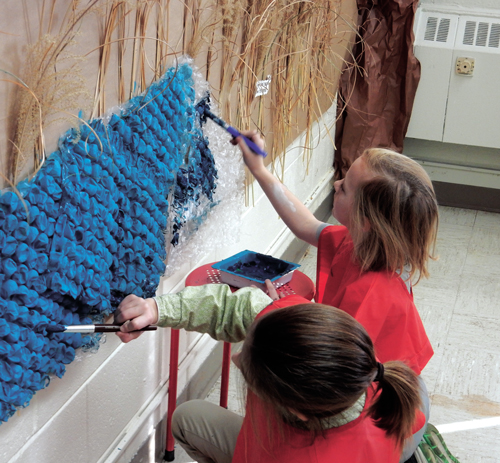Project Approach: Sayre Students Enjoy Hands-on, Real-World Experiences
Curiosity and discovery are inherent traits in children. Sayre School capitalizes on that curiosity by marrying learning with real world situations through the Project Approach.
Based on the work of educators Lilian Katz, Sylvia Chard and Judy Harris Helm, Project work is three-phase model that guides children through in-depth studies of real-world topics.
“It’s respectful of children’s abilities to think for themselves, ask good questions, conduct authentic research, and use their findings to draw sound conclusions,” said Annie Papero, Sayre’s head of Lower School for the past two years.
Papero has worked in education for 23 years – much of that time using the Project Approach – and has seen the effectiveness of the model.
Project work doesn’t replace comprehensive curriculum or direct skills instruction in the classroom but simply enhances it.
Building on a long history of rich, integrated, hands-on learning at Sayre, Papero has ensured that the Project Approach is consistently utilized throughout the Lower School
“This model is so solid and so rich,” she said. “It provides an amazing vehicle which allows students to apply the discreet skills they have learned to a real life situation in a purposeful way,” she said.
Children in preschool through fifth grade all participate in Project work at Sayre. Each Project lasts up to eight weeks, allowing students to go deeply into the topic and really “live it and explore it,” Papero said.
The Project Approach consists of three stages:
First, teachers watch for areas of interest in the children to naturally emerge.
Projects should be child-directed, so teachers look at what the students already know, what resources they have, field trip possibilities and accessibility for the kids.
Children identify the questions they would like to answer during this phase.
Second, students conduct research and collect data that will allow them to answer their original questions.
Research can include taking a field trip, interviewing an expert, using print and electronic resources, conducting experiments, and making careful observations.
Finally, students conclude their project with a culminating event which allows them to share the information gained through their research.
For preschool-aged children, culmination often takes the form of dramatic play.
As children mature, culminating activities may be performances, narrated museums, research papers, art projects, or other creative activities that allow students to share their new knowledge.
Some examples of project work conducted this year in their classrooms include:
- A class of 4-year-olds was interested in cars, so they learned about engines, how gears work and also built their own car for dramatic play.
Their research included interviewing an employee from Toyota, examining several different types of vehicles closely, and hosting several other experts in their classroom.
- First graders were fascinated by storms, so students used different print and electronic resources, visited and interviewed a TV meteorologist, studied lightning and “blackouts,” and interviewed farmers about what animals do in a storm.
Their culmination event included conducting focused research on a particular topic and writing a knowledge piece that described their findings.
Many groups also created 3-D representations of their learning. This information was then shared orally during a parent visitation.
Writing a focused, informative piece is challenging for first graders, but it helps when they are enthused by the subject and are writing from their own research.
“We obviously teach them to write, but it is particularly exciting to watch when they write about something they care about,” Papero said. “Answering their own questions is meaningful to them.”
All projects are vocabulary rich and these words take a firm hold in a child’s memory because they are using the words in a real life context.
“When else would a 3-year-old be able to use the word ‘dispatcher?’”
“But while working on a project about fire stations, Sayre 3-year-olds used that word along with many others such as gauge and extinguish.” Papero said.
During a project on cameras, children 4 to 6 years old learned vocabulary such as “lens,” “shutter,” “develop,” “focus,” and “view finder.”
- Fourth graders researched Greek gods and goddesses for a project. Along with a school art teacher, the students toured downtown Lexington to identify local architecture inspired by the Greeks.
For their culmination event, the students took on the persona of specific gods and goddesses, wrote their own poetry, created backdrops and performed to music that they themselves created.
Project work is exciting and fun for children and also develops 21st Century skills such as collaboration, persistence, critical thinking and cooperation.
Although skill levels obviously vary across age groups, Papero said, the Project Approach spans every grade in the Lower School and is successful in each one.
“It’s quite remarkable that we can take a model and apply it to an entire school that spans nine years of development,” she said. “It’s so adaptable.
“It allows children to go as far as they want and are able to go. Project work gives children ownership of their learning. They are proud of their accomplishments.”

